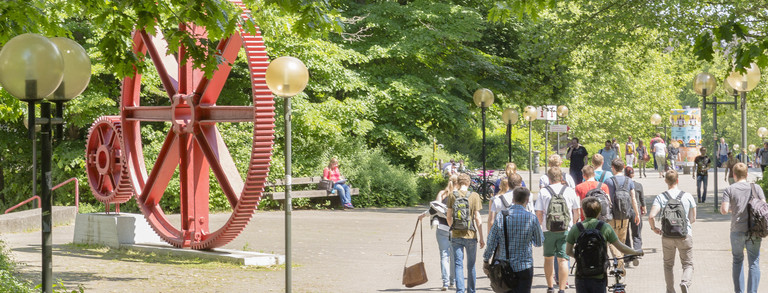Der Campus der Technischen Universität Dortmund liegt in der Nähe des Autobahnkreuzes Dortmund West, wo die Sauerlandlinie A45 den Ruhrschnellweg B1/A40 kreuzt. Die Abfahrt Dortmund-Eichlinghofen auf der A45 führt zum Campus Süd, die Abfahrt Dortmund-Dorstfeld auf der A40 zum Campus-Nord. An beiden Ausfahrten ist die Universität ausgeschildert.
Direkt auf dem Campus Nord befindet sich die S-Bahn-Station „Dortmund Universität“. Von dort fährt die S-Bahn-Linie S1 im 15- oder 30-Minuten-Takt zum Hauptbahnhof Dortmund und in der Gegenrichtung zum Hauptbahnhof Düsseldorf über Bochum, Essen und Duisburg. Außerdem ist die Universität mit den Buslinien 445, 447 und 462 zu erreichen. Eine Fahrplanauskunft findet sich auf der Homepage des Verkehrsverbundes Rhein-Ruhr, außerdem bieten die DSW21 einen interaktiven Liniennetzplan an.
Zu den Wahrzeichen der TU Dortmund gehört die H-Bahn. Linie 1 verkehrt im 10-Minuten-Takt zwischen Dortmund Eichlinghofen und dem Technologiezentrum über Campus Süd und Dortmund Universität S, Linie 2 pendelt im 5-Minuten-Takt zwischen Campus Nord und Campus Süd. Diese Strecke legt sie in zwei Minuten zurück.
Vom Flughafen Dortmund aus gelangt man mit dem AirportExpress innerhalb von gut 20 Minuten zum Dortmunder Hauptbahnhof und von dort mit der S-Bahn zur Universität. Ein größeres Angebot an internationalen Flugverbindungen bietet der etwa 60 Kilometer entfernte Flughafen Düsseldorf, der direkt mit der S-Bahn vom Bahnhof der Universität zu erreichen ist.
Teil von:
Fakultät Bio- und Chemieingenieurwesen
Sie sind hier:
15:00 – 16:00 | Registration (Foyer of Emil-Figge 50) |
16:00 – 16:20 | Opening remarks & Welcome addresses |
16:20 – 17:20 | PL1 - Alessandra Eustaquio, University of Illinois at Chicago Reverse genetics and heterologous expression for natural product discovery |
17:20 – 18:30 | Poster pitches I Chair: Markus Nett, TU Dortmund University Session “Discovery” (posters P1-P22) Session “Evolution, Regulation & Function” (posters P23-P31) |
18:30 – 20:00 | Poster presentation I on site with finger food and drinks as well as online with interactive user interface (Gather Town) |
Lecture Session “Discovery” Chair: Hajo Kries, Hans Knöll Institute, Jena | |
09:00 – 09:15 | SL1 – Therese Horch Alternative benzoxazole assembly discovered in anaerobic bacteria provides access to privileged heterocyclic scaffold |
09:15 – 09:30 | SL2 – Sophie Jünger Discovery and biosynthesis of methanobactin-like peptides in non-methanotrophic bacteria |
09:30 – 09:45 | SL3 – Pakjira Nanudorn Atropopeptides are a novel family of ribosomally synthesized and posttranslationally modified peptides with a complex molecular shape |
09:45 – 10:00 | SL4 – Sebastian Walesch Revisiting Angiolams, a class of neglected antibiotics from myxobacteria |
10:00 – 10:15 | SL5 – Elena Seibel Amycolatopsis spp. – a neglected source for novel natural products and biosynthetic pathways |
10:15 – 11:00 | Coffee break on site and virtual (Gather Town) |
11:00 – 12:00 | PL2 - Emily Patricia Balskus, Harvard University Chemical discovery in the microbial world |
12:00 – 12:30 | VAAM Business Meeting |
12:30 – 14:00 | Lunch |
Lecture Session “Biosynthesis” Chair: Eric Helfrich, Goethe University Frankfurt | |
14:00 – 14:15 | SL6 - Sophie Klöppel Structural and biochemical insights into the transesterifying thioesterase domain from FR900359 biosynthesis |
14:15 – 14:30 | SL 7 - Mahmudul Hasan Evolutionary insights into the biosynthesis of coenzyme 3PG-F420 |
14:30 – 14:45 | SL8 - Nancy Magnus Identification of non-canonical terpene biosynthetic routes in bacteria |
14:45 – 15:00 | SL9 - Lena Barra NAD as a building block in natural product biosynthesis |
15:00 – 15:15 | SL10 - Silja Mordhorst Structural and biochemical characterisation of the peptide arginase OspR from landornamide biosynthesis |
15:15 – 15:45 | Coffee break on site and virtual (Gather Town) |
15:45 – 16:45 | PL3 –Gregory Challis, University of Warwick Gladiolin biosynthesis as a model for understanding complex metabolite assembly by trans-AT polyketide synthases |
| 16:45 – 18:00 | Poster pitches II Chair: Stephan Lütz, TU Dortmund University Session “Biosynthesis” (posters P32-P45) Session “Engineering & Synthesis” (posters P46-P64) |
| 18:00 – 19:30 | Poster presentation II on site as well as online with interactive user interface (Gather Town) |
| 19:30 | Dinner and Get together |
| Chair: Helge Bode, MPI for Terrestrial Microbiology, Marburg Hendrik Wolff Award | |
| 08:30 – 09:00 | Award lecture |
| Lecture Session “Engineering & Synthesis” Chair: Till Schäberle, Justus-Liebig-University Giessen | |
09:00 – 09:15 | SL11 – Irina Voitsekhovskaia Generation of novel glycopeptide antibiotics using mutasynthesis approach |
09:15 – 09:30 | SL12 – Huiyun Peng Programming nonribosomal peptide synthetases with DNA templates |
09:30 – 09:45 | SL13 – Kilan Schäfer Biochemical and metabolic engineering of Saccharomyces cerevisiae for the production of cannabinoid precursors |
09:45 – 10:00 | SL14 – Fabrizio Alberti Pleuromutilin biosynthesis and production of its congeners through heterologous gene expression in fungi |
10:00 – 10:15 | SL15 – Svetlana Kalinina Novel microscale semi-synthetic approach toward biologically active isoindolinones from S. chartarum |
| 10:15 – 11:00 | Coffee break on site and virtual (Gather Town) |
Lecture Session “Evolution, Regulation & Function” Chair: Yvonne Mast, Leibniz Institute DSMZ, Braunschweig | |
11:00 – 11:15 | SL16 – Wiebke Hanke Effects of the Gq inhibitor FR900359 on soil nematodes |
11:15 – 11:30 | SL17 – Athina Gavriilidou Sugar and spice: reclassifying glycopeptides and related antibiotics |
11:30 – 11:45 | SL18 – Judith Boldt Transcription of BGCs and production of natural compounds in the myxobacterium Sorangium sp. |
11:45 – 12:00 | SL19 – Maria Stroe On the role of natural products as virulence factors in fungi with a predatory lifestyle |
12:00 – 12:15 | SL20 – Sergii Krysenko Polyamine and ethanolamine utilization in Streptomyces coelicolor |
12:15 – 12:30 | Poster awards and Closing remarks |

